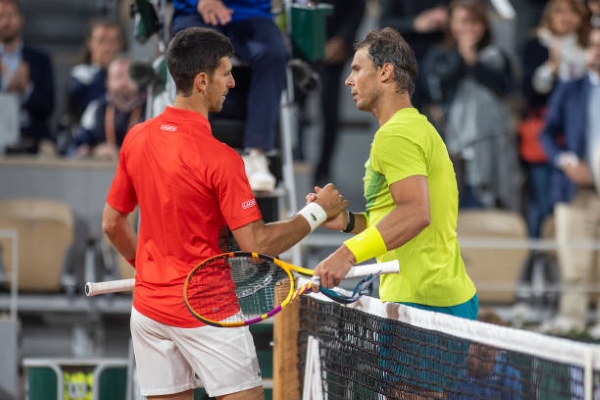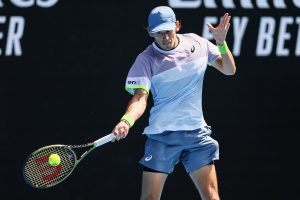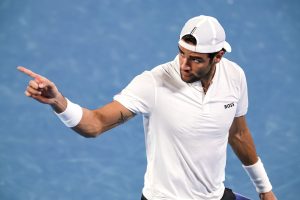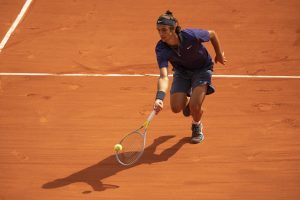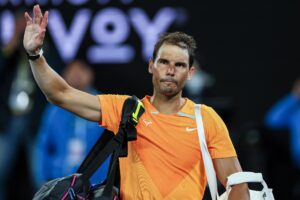In the fourth and final part of our series examining the extraordinary three-way “Trivalry” between Federer, Nadal and Djokovic, which has ended with Federer’s retirement, Martin Keady, our resident tennis historian, examines the specific rivalry between Nadal and Djokovic.
The rivalry between Rafael Nadal and Novak Djokovic is, of course, the one rivalry within the greater Federer-Nadal-Djokovic Trivalry that has not ended with Roger Federer’s retirement. Nadal and Djokovic continue to compete against each other and may well do so for some time yet. Nevertheless, now that the Trivalry itself has ended, it is still appropriate to assess the historic nature of their own particular rivalry and consider how it might develop in the post-Federer future.
The Major Men’s Rivalry Of The Last Decade
In truth, such has been the duration of Federer’s long retirement from the sport – effectively, it had been going on for the last three seasons – that Nadal, Djokovic and every other male tennis player has already become accustomed to the absence of the great Swiss from the ATP Tour. And that is in keeping with the trend of the last decade, where the major rivalry in men’s tennis has been that between Nadal and Djokovic, with only occasional interruptions by Federer, notably in his remarkable comeback seasons of 2017 and 2018, when he won the last three of his 20 Majors.
That extraordinary late, great phase of Federer’s career had initially looked as if would propel him far beyond the reach of even his greatest rivals. When Federer won his 20th and last Major in Melbourne at the start of 2018, becoming the first male tennis player to reach that landmark, Nadal and Djokovic were “only” on 15 Majors and 12 Majors respectively. Since then, however, as Federer slowly came to terms with the injuries that eventually ended his career, Nadal and Djokovic have won a frankly astonishing seven and nine Majors respectively, and this year they both broke what had been a three-way tie with Federer on 20 Majors to go to 22 Majors and 21 Majors respectively.
If Federer-Nadal was undoubtedly the great rivalry in men’s tennis in the second half of the noughties, for almost all of the last decade Nadal-Djokovic has replaced it as the pre-eminent contest in the sport. That would not necessarily have been predicted at the start of the decade, when Nadal won the last three Majors of 2010 to establish himself as the undisputed World No.1. But then came Djokovic’s breakthrough season of 2011 and a decade of almost complete domination at the Majors by the Serb, other than at Roland Garros where Nadal continued to reign supreme.
The History of the Nadal-Djokovic Rivalry
Djokovic won his first Major at the 2008 Australian Open, but it was another three years before he won another, again in Melbourne. The main reason why he was transformed at the start of the 2011 season was the belated diagnosis of his gluten intolerance, which had previously caused numerous niggling injuries and ailments.
Once he was free of his medical concerns, Djokovic played like a man who had been completely liberated and went on one of the all-time great winning streaks in men’s tennis. After claiming his second Australian Open, he simply kept on winning, even on the clay courts of Europe that had virtually been Nadal’s personal fiefdom for the previous half a decade. Indeed, after an astonishing 41-match unbeaten start to the 2011 season, Djokovic was just one match away from equalling John McEnroe’s 1984 record of going 42 matches unbeaten at the start of a calendar year when he was ambushed by a resurgent Federer in the French Open semifinal.
Having lost that match, however, Djokovic barely lost another match for the rest of 2011 and none at all at the remaining Majors, as he won Wimbledon and the US Open for the first time, beating Nadal in both finals. And he continued that unbeaten streak at the Majors into 2012, when he and Nadal played their greatest ever match, the 2012 Australian Open final (more on that later), which Djokovic eventually won after nearly six hours of extraordinary play.
Billie-Jean King, in continually arguing that men should play three-set matches at the Majors rather than women playing five-setters, has often claimed that that 2012 Australian Open final was so physically demanding that it effectively shortened both players’ careers by at least a year. And yet there is no evidence of that, because 10 years on from it Djokovic and Nadal are still at or near the top of the men’s game and between them have won three of the four men’s Major titles in 2022.
After that epic early in 2012, Djokovic dominated the Majors for the rest of the decade, except in one particular corner of the French capital that was forever (or nearly forever) Nadal’s. That, of course, was Roland Garros, where Nadal defeated Djokovic in both the 2012 and 2014 finals. In addition, Nadal won the 2013 US Open Final against Djokovic when the Serb was in the first of only two phases of relative failure in the last 10 years: the first came in 2012-13 when he lost several Major finals not only to Nadal but to Andy Murray; and the second came after he had finally completed the Career Grand Slam by winning the French Open in 2016.
As Djokovic went mentally walkabout for nearly two years after that, during which time he did not win a single Major, it was not only Federer who made a great comeback but Nadal himself. Federer won three of the four Majors that he competed for from the start of 2017 to the start of 2018 (he deliberately missed the French Open to save himself for Wimbledon) and Nadal won the other two, claiming both the French Open and the US Open in 2017. For a while, it was like 2007-08 all over again, with the old Federer-Nadal duopoly re-established and Djokovic back on the outside.
Then, of course, came Djokovic’s own great comeback, beginning with his Wimbledon win in 2018. As the final great phase of Federer’s career eventually came to an end with his loss, from two sets up, to Kevin Anderson in the 2018 Wimbledon quarterfinal, it was left to Djokovic and Nadal to determine who would succeed him as Wimbledon champion. Ultimately, it was Djokovic, after he won a truly epic semifinal against Nadal 10-8 in the fifth set and then comfortably beat Anderson in the final.
That was the last five-set encounter between Nadal and Djokovic at the Majors. They have met at Grand Slams several times since, even in finals, but the matches have generally been one-sided: Djokovic thrashed Nadal in straight sets in the 2019 Australian Open final, in what was one of the greatest eviscerations of an opponent (especially one as good as Nadal) ever seen in a Major final; and 18 months later Nadal gained his revenge by inflicting a similar thrashing on Djokovic in the final of the Covid-affected autumnal French Open of 2020.
When the French Open returned to its normal spring setting in 2021, Nadal and Djokovic fought out what to date has been their last truly epic encounter at the Majors, even if it did not go all the way to five sets. That was largely because the third set between them, which Djokovic eventually won 7-4 in a tie-break, was arguably the greatest single set of tennis ever played, lasting well over an hour and being described by the ITV Sport commentator Nick Mullins as a “symphony”. Typically, however, although that classic went Djokovic’s way, Nadal soon reasserted his dominance over Djokovic at Roland Garros by beating him in this year’s quarterfinal, en route to winning a 14th French Open title.
The Present And Future Of The Nadal-Djokovic Rivalry
Because of their advancing years (Nadal is now 36 and Djokovic 35) and particularly because of Nadal’s continuing injury woes, which curtailed his chance of attempting to win the Calendar Slam this year after winning the first two Majors of 2022, it is probable that the Nadal-Djokovic rivalry is entering its final phase. But what a weird final phase it has already proved to be.
That is because Djokovic, after nearly conquering the tennis world completely in 2021 by winning a Calendar Slam himself (he fell at the last hurdle, the US Open final, to Daniil Medvedev) and certainly conquering the hearts of many tennis fans with his Herculean efforts over that season (he was hailed in defeat in New York as he was rarely hailed in victory elsewhere), effectively conspired to shoot, or at least jab, himself in the foot. His refusal to receive the Coronavirus vaccine turned “Novak”, who for the first time ever was beginning to receive the widespread adoration that Federer and Nadal had enjoyed for years, into “No-Vax”, public enemy No.1, certainly in Australia, where he was not allowed to compete this year and may never be allowed to compete again.
The same controversy prevented Djokovic from competing at the US Open, meaning that he has only played in two of the four Majors in 2021 and potentially may only play half of the four Majors in each of the coming years, unless both Australia and the US revise their bans on non-vaccinated foreign entrants and Australia revokes its five-year ban on his returning to the country. If that proves to be the case, then Djokovic will undoubtedly have damaged his chances of becoming the most successful male tennis player ever. Nadal is already ahead of him on 22 Majors and even allowing for the fact that the Spaniard will probably miss future Majors because of injury, that may ultimately prove to be the decisive factor in the all-time Major race.
There is another factor to consider, namely the entrance of a new “Third Man” in men’s tennis, Carlos Alcaraz. At 19, Alcaraz is really still a man-child, but he has already done enough in 2022, notably winning the US Open and defeating both Nadal and Djokovic on successive days in Madrid, to suggest that if he is not their equal already then he soon will be. Given the vast difference in ages between Nadal and Djokovic and the still-teenaged Alcaraz, such a “Trivalry” cannot last nearly as long as the original Trivalry of Federer-Nadal-Djokovic. But it will surely be absolutely compelling to watch while it does.
The Five Finest Nadal-Djokovic Matches At The Majors
- The 2013 US Open Final: Nadal Wins 6–2, 3–6, 6–4, 6–1
Having lost both the 2012 US Open final and the 2013 Wimbledon final to Andy Murray, Djokovic made it an unwanted hat-trick of Major final losses within a year when he succumbed to Nadal in four sets in New York in September 2013. Djokovic generally held the upper hand over Nadal on hardcourts, especially in Melbourne, but in New York in 2013 Nadal won the second of his four US Open titles.
- The 2012 French Open Final: Nadal wins 6–4, 6–3, 2–6, 7-5
In Paris in 2012, Djokovic bemoaned the elements for possibly costing him his first Roland Garros triumph. That year, the French Open final was halted by rain in the fourth set, after Djokovic had won the third set and appeared to be clawing his way back into a match that Nadal had dominated. However, the rain interrupted his resurgence and when they returned the next day to complete the final, Nadal closed it out in relatively straightforward fashion.
- The 2011 US Open Final: Djokovic Wins 6–2, 6–4, 6–7 (3–7), 6–1
There have been so many great encounters at the Majors between any two of Federer, Nadal and Djokovic that it is easy to forget some of the slightly less extraordinary ones, especially if they did not extend to five sets. The 2011 US Open final is probably the best example of that. It was a marvellous match that Djokovic initially dominated before Nadal came fighting back to win a magnificent third set on a tie-break. At that point, the great Spanish bull appeared unstoppable, but with characteristically brilliant defence Djokovic stalled his charge and eventually won the fourth set 6-1 and with it the title.
- The 2018 Wimbledon Semi-Final: Djokovic Wins 6-4, 3-6, 7-6 (11-9), 6-3, 10-8
As with the top two matches between Federer and Nadal, and the top two between Federer and Djokovic, the top two matches on this list are truly outstanding, even in the context of all the great matches that Nadal and Djokovic have played. That is despite the fact that it is often overlooked because it followed the longest ever Wimbledon semifinal between Kevin Anderson and John Isner, which Anderson eventually won 26-24 in the fifth set. The second semifinal did not last quite as long as the great “serving match” between Anderson and Isner, but it was immeasurably greater in every other respect. Djokovic eventually triumphed 10-8 in the fifth set, which was played on the following day after the late start caused by the incredible duration of the Anderson-Isner match.
1.The 2012 Australian Open Final: Djokovic Wins 5–7, 6–4, 6–2, 6–7 (5–7), 7–5
The 2012 Australian Open final between Nadal and Djokovic is the only match between any two of Federer, Nadal and Djokovic that comes close to equalling the 2008 Wimbledon final between Federer and Nadal, which is usually described as the greatest tennis match of all time. Indeed, some tennis fans and commentators argue that the Nadal-Djokovic epic actually exceeds the 2008 Federer-Nadal classic in quality.
It certainly exceeded it in length, lasting for nearly six hours as opposed to the five hours that Federer and Nadal competed for in 2008. However, although tennis is undoubtedly a numbers game (increasingly so in the data-driven days of the 21st century), mere numbers alone cannot do justice to the greatness of the 2012 Australian Open Final. Instead, it would require a Homer or Shakespeare to find the words to do justice to a true 21st-century epic. Djokovic eventually prevailed, but this match, along with the 2008 Wimbledon Final, will forever be cited as evidence for the unparalleled greatness of The Trivalry in tennis and indeed sporting history.
Main photo:
Embed from Getty Images


